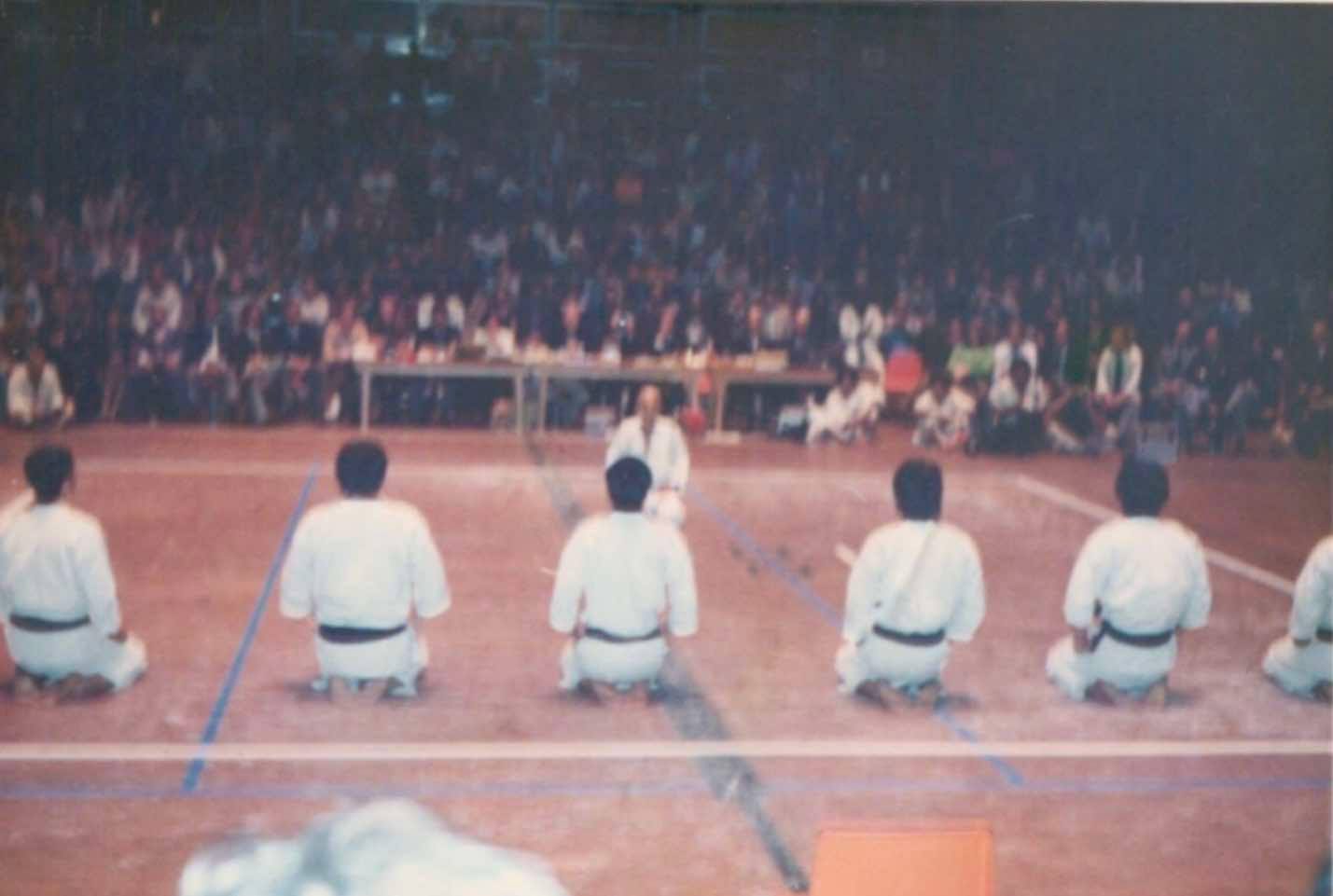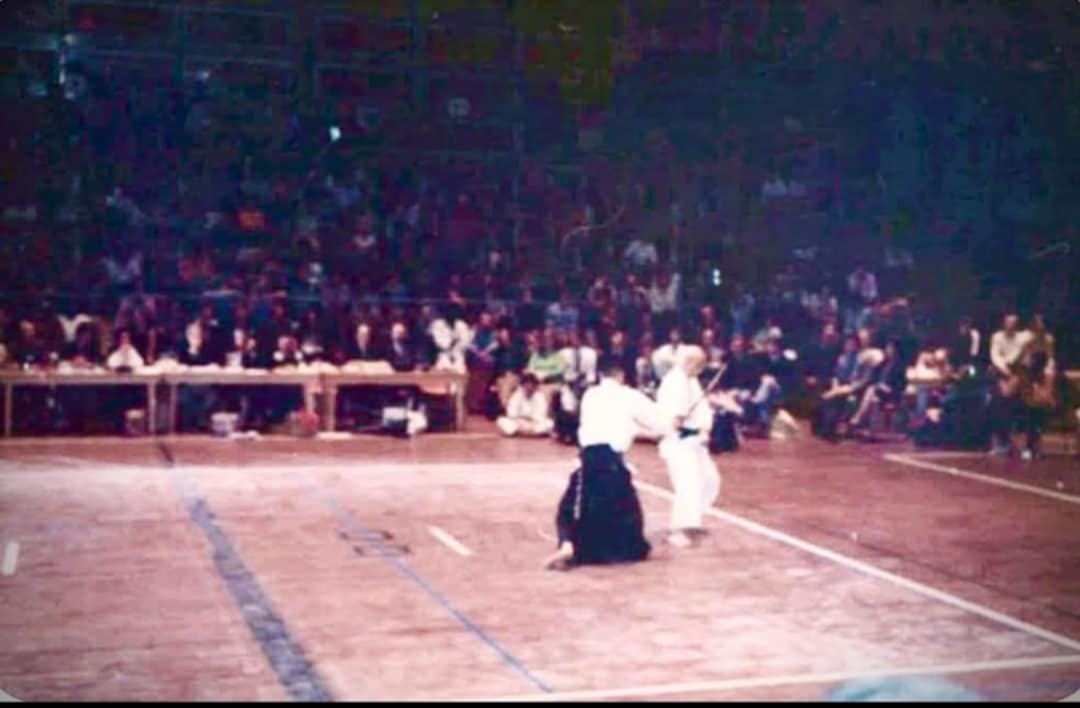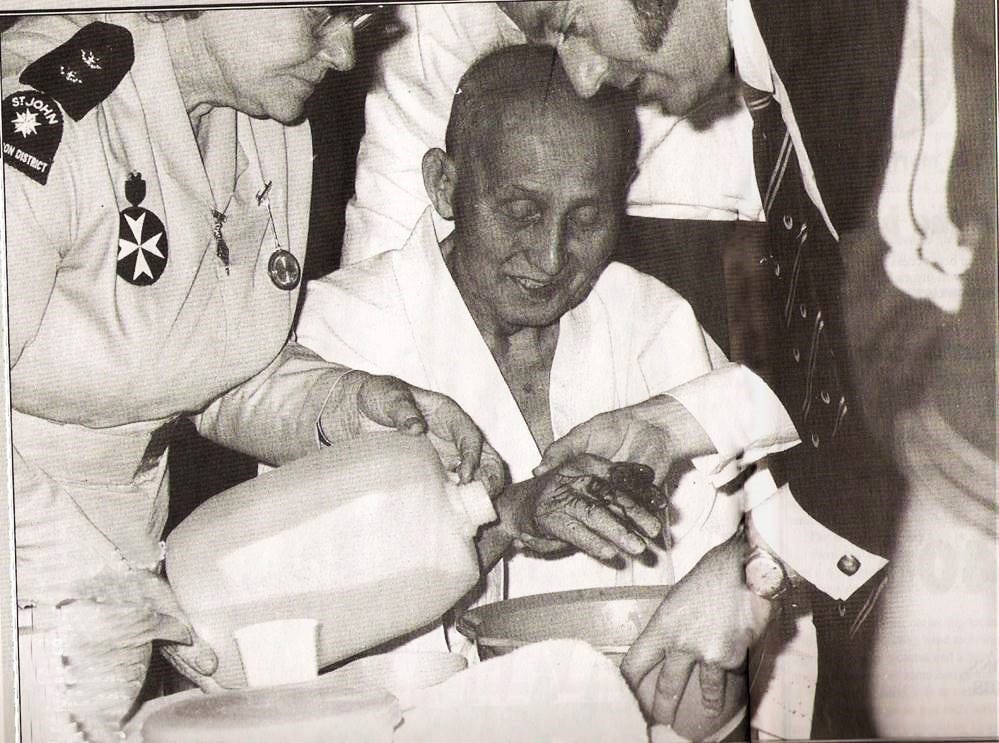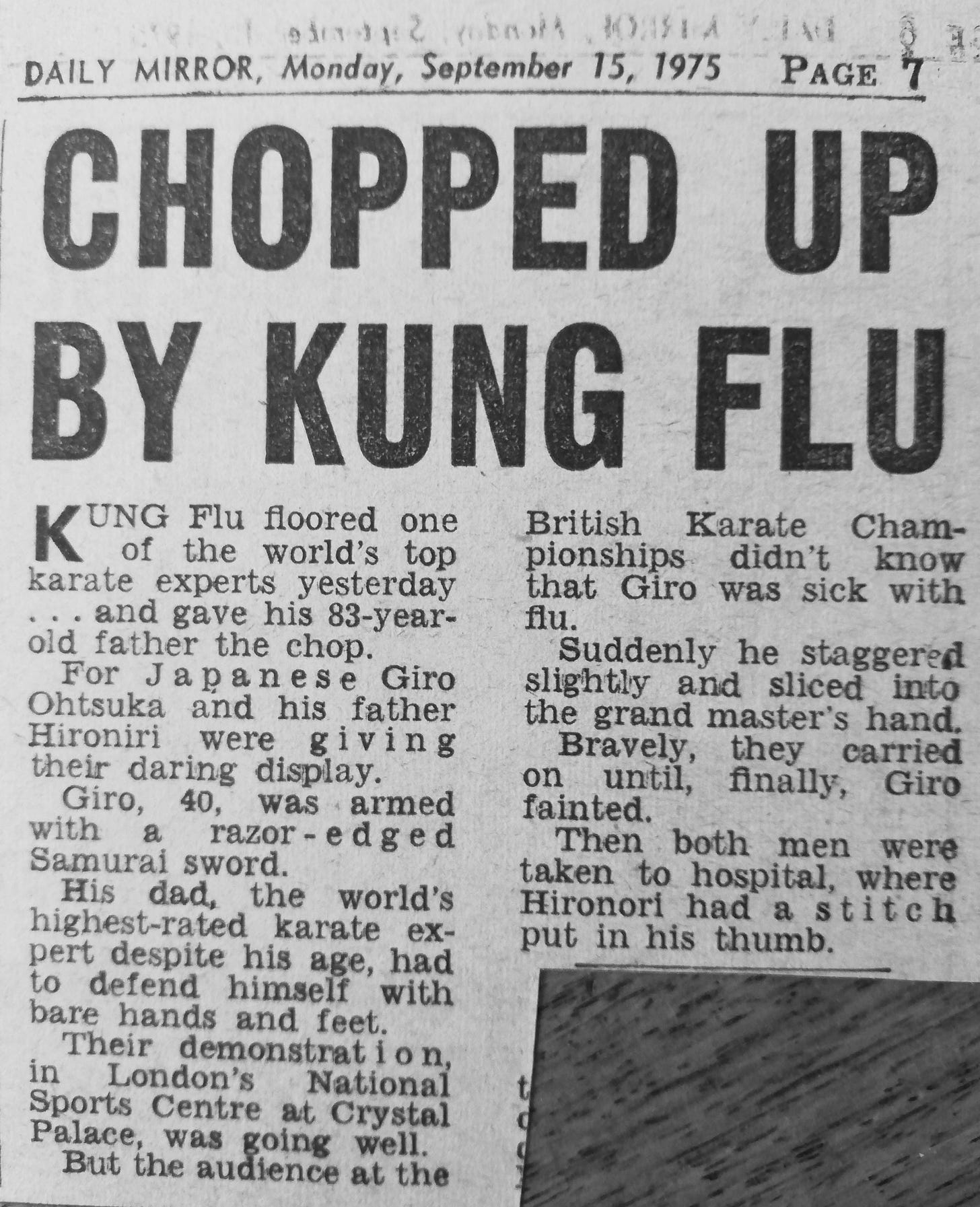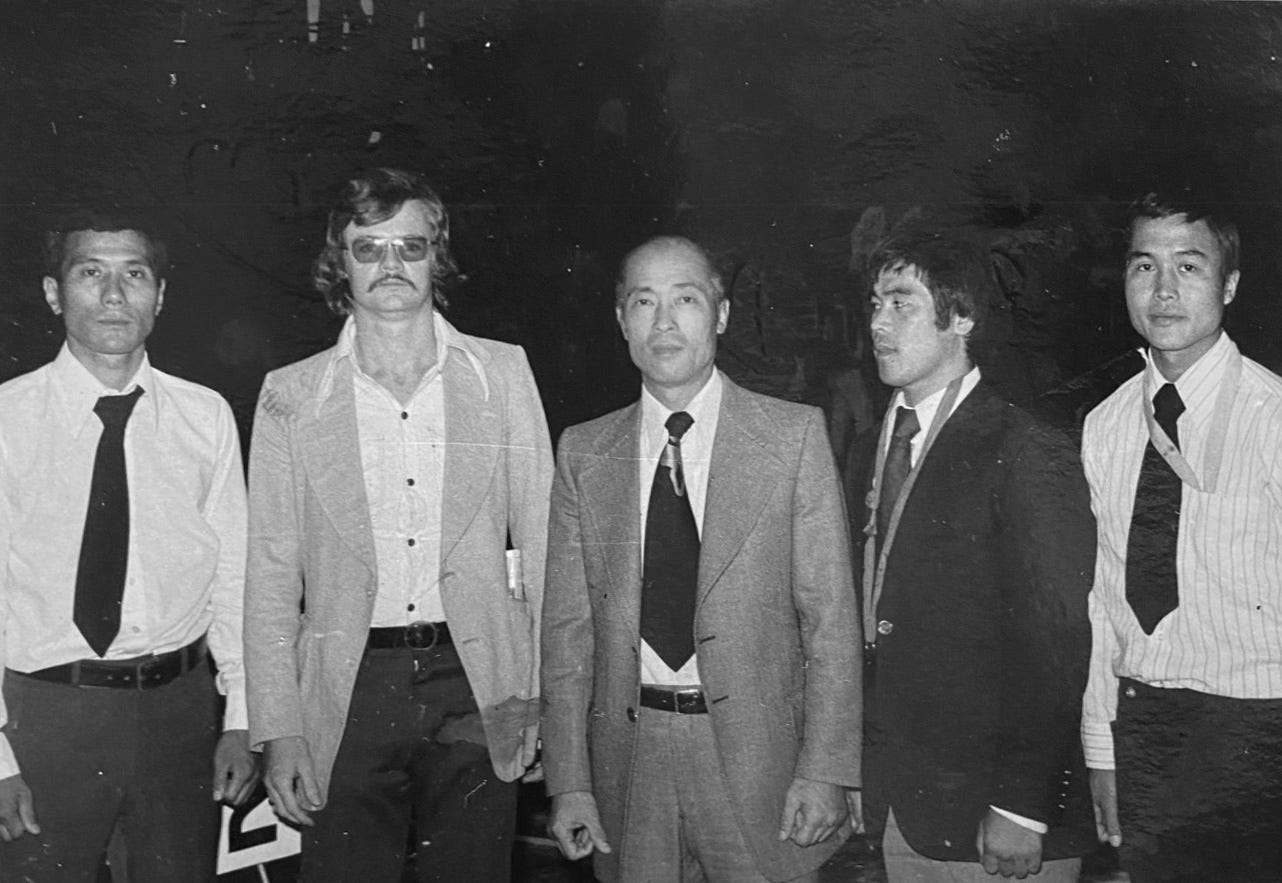The demonstrations.
Otsuka Sensei (in Keikogi) lined up in front of an impressive array of Japanese Wado Sensei and bows were taken in an appropriate and respectful manner.
Otsuka Sensei in front of the other Japanese Sensei.
According to accounts in magazines of the time, the first presentation featured Suzuki Sensei and Sakagami Sensei demonstrating Niseishi kata. Then Suzuki Sensei peeled off to give his signature defence against tanto and short stick – always guaranteed to bring the house down (Uke were Senseis Maeda and Kitamura).
Sakagami Sensei then did a four-man defence. This was then followed by a chair defence by Maeda and Kitamura. Again, these were crowd-pleasers; dynamic, athletic and very carefully choreographed; this was showy and very much fitted in with the expectation of the audience, and probably went beyond what an English crowd had thought was possible, hence the rapturous applause that followed.
A hush descended; house lights had been lowered.
Otsuka Sensei, father and son, demonstration was left till last. The contrast was noticeable; this was a different category of presentation.
I was aware that some people were attempting to capture the demonstration on film. Someone from our Dojo had a Super-8 cine camera which was rattling away near where I was sitting.
Otsuka Jiro Sensei walked out with his father in hakama and carrying a sword (Shinken 真剣 = ‘real’ or ‘live’ sword).
They presented us with a peerless demonstration. I have to be honest, on that day I had very little idea as to what was going on, but I had enough about me to understand that here was something special, even possibly, unique.
As the younger Otsuka slashed at him with the sword he moved smoothly and effortlessly to avoid the blade, it appeared almost casual. I was later told by my Sensei that if it looked effortless, that was entirely the point; if it looked like you were trying then you were either hamming it up, or you were genuinely struggling; Otsuka Sensei made it look so so relaxed; the blade, which was razor sharp, missed him by a whisker, which was really impressive, until…
This blurry photograph shows what I believe was the actual nano-second that Otsuka Sensei left his right hand in the path of the blade.
Otsuka Sensei must have left himself temporarily in the path of the descending blade and it sliced across the back of his right hand to create a cut that later required a stitch. But, from my perspective, all I saw was dark spots appearing on his keikogi top; it did not really make sense, and then I realised it was blood. But, surprisingly, he wasn’t fazed, he continued all the way through to the end of the demonstration. The St John’s Ambulance people seemed to be able to cater to his needs; he smiled benignly, as if it was nothing more than a mere scratch.
Otsuka Sensei seems almost amused as he receives medical attention. Note how the injury is to his right hand.
Picture credit: Combat magazine.
To put it into context, with the wider spectrum of Otsuka Sensei’s experience; it is said that he took amazing risks in his younger days, facing both the sword blade and the dagger, and as such was cut many times (Suzuki Sensei said he sprang like a cat away from the slashing blade) an injury like this wasn’t going to worry him.
Talk afterwards suggested that the error was with the swordsman. There were hints that Otsuka Jiro Sensei was unwell and had a viral infection, even that he had fainted. I personally didn’t see that myself. It was picked up in the national press; The Daily Mirror (with its typical tabloid tone) had this to say:
The British popular press put its own spin on the story.
Of course, all of these goings on delayed and extended the evening; the finals were very very late; we got back to Mansfield at some unearthly hour.
A brief word about Alex Waith, who was there on the day and kindly gave me access to some of his personal archive.
Alex Waith (second L) with the Japanese Sensei.
Other perspectives:
I contacted other people who I know were there and asked what they saw and experienced at the time.
Dave Shephard:
“1975; that year I was 13 years old. The day started at about 10.00am with all the Kumite preliminaries. I actually would have been sitting on the benches probably somewhere near the photographer. I always sat on the benches below the gantry and facing the windows. Usually, the demonstrations would start about 8pm. But this year there had been a bomb scare.
1975 the IRA were very active, (Guildford and Birmingham pub bombings were the year before). So bomb scares were a serious business. I recall the announcement over the tannoy that there had been a bomb threat and we were all to vacate the building calmly. It must have been early evening because I recall standing out in the pouring rain and it was still daylight. I was cold and wet.
Because of this, the event was probably 1½-2 hours behind schedule before the demos eventually kicked off. During the sword defence demo Ohtsuka must have misjudged or mistimed his movement or his son Jiro mistimed his technique. Either way Ohtsuka Meijin received a cut to his hand with the razor-sharp sword. Cards on the table, I didn't even notice because he brought a handkerchief out of his Dogi to hold in his injured hand. It was after the demo was over that I noticed him receiving first aid!”
Steve Byfield; then 14 years old and a regular training with Suzuki Sensei and the other Japanese Sensei in London.
“At that time I knew little, if anything at all about Otsuka Hironori. I was sitting in the stand and Jumana El Homsi (my first sensei in the Manor Place kids class) beckoned me to come down to her position at the side of the demonstration area, I sat down cross legged and remember her words clearly: "I want you to watch this carefully, this will be something special". I thought Otsuka sensei looked old and very frail at the time with my young eyes; then when I saw the sword I just had this strong sense of foreboding. I could clearly hear the 'swish' as the katana cut through the air, and remember thinking that although Otsuka was quite agile I just didn't like the idea of a sword against empty hands; something that endures to this day.
I was watching all this transfixed, then I thought I saw something that didn't look intentional, just the whisper of the merest hiccup, but couldn't be sure? Then I noticed a couple of drops of blood on the area, as well as on Otsuka sensei's dogi and knew something had happened. I studied Otsuka sensei carefully throughout, and he showed no reaction at any time, and continued for a while after the injury, completing the demonstration.
Afterwards, concerned people huddled around him, and I followed the little huddle of people to see what was happening as they moved behind the scenes; a St John first aider was dabbing at the wound on Otsuka sensei's hand, and that was when I saw the only reaction from him, a hint of a smile; which seemed incongruous since everyone else looked so concerned. Anyway, those are my recollections, and I'll never forget that day!”
David Allsop:
“I was very close to Otsuka and his son when they did their demonstration. I heard a very short hissing sound that seemed to be not normal. I think Otsuka wrapped a tissue around his hand and carried on. I couldn't see how bad it was because there wasn't much time between the cut and them going on.
I seem to remember they carried on for a short time. I can't be sure though because it was a shock and all over so fast. There didn't seem to be any fuss at all. Otsuka obviously knew he was cut, but, as far as I could see, he didn't make anything of it.
Suzuki told me they took him downstairs at the Palace to get him dressed up. He said Jiro was very upset and not feeling very well. I thought it was his left hand but it was so quick I can't say for sure”.
Conclusion.
Although it was a very long time ago, certain events and encounters have a way of running through your head like video tape. The risk is that in the retelling the story gets warped or more grainy, with details lost and details added. This is partly why I added the extra witnesses, as well as wanting to challenge my own recall.
In addition, I think it was Otsuka Sensei’s coolness and rock-steady focus that to me suggests he was a man of a different era. Here was someone who, as a youngster, encountered daily the remnants of the Boshin War, the last of the samurai (his mother’s uncle in particular). It might be fanciful but I think for those of us who encountered Otsuka Sensei we could claim, in some small way, a vicarious connection to the shades of those 19th century warriors who experienced the last gasp of the old regime in Japan.1
Thanks again to Alex Waith and for the memories of Dave Shephard, Steve Byfield and David Allsop.
The event was recorded in Combat Magazine; Karate and Oriental Arts (Nov to Dec 1975) and Fighting Arts magazine, Vol 2, No. 5. Also, the details of the fuller demonstrations and the actual contest, with David Allsop meeting Vic Charles in the final (Charles was the eventual winner), can be found in Ben Pollock’s excellent book, ‘Karate Wadoryu – From Japan to the West’ (pages: 136 to 138).





